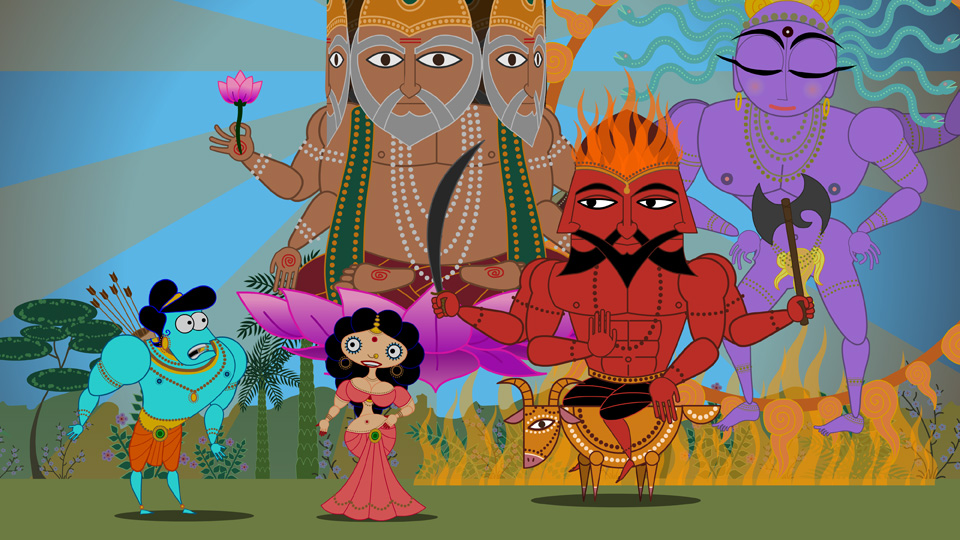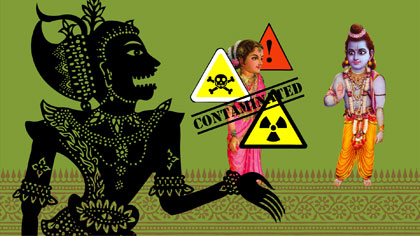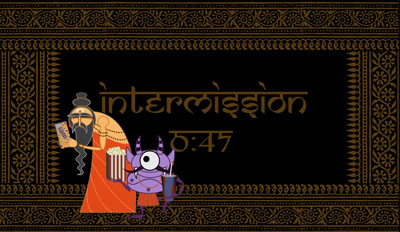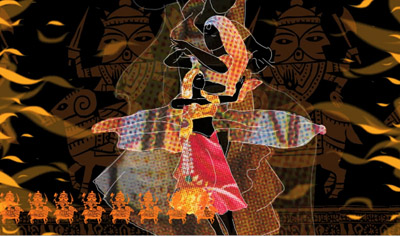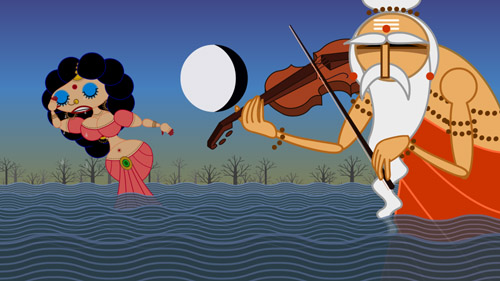Kristin here–
As I mentioned in our main entry about Ebertfest, Nina Paley’s animated feature, Sita Sings the Blues, was one of the highlights of the festival. Afterward I had the privilege of moderating the onstage discussion with the director and University of Illinois film professor Richard Leskovsky, who has a special interest in animation.
Sita has not had a regular theatrical release, though Nina has made it available to theaters, festivals, and everyone with access to a high-speed internet link-up. She gives it for free to anyone who wants it, believing that people who see it will pass the word along and that as the film becomes more well-known, it will become more valuable as well. Income should flow in. Nina is confident, some might say cocky about this. The thing is, she may be right. Sita is a terrific film, and I can well imagine a ground-swell of interest gradually building. Indeed, it’s happening already. Here I am, blogging about it, and others are as well. Non-bloggers are emailing their friends. Festivals have booked it up to the end of this year and beyond.
Roger Ebert found Sita early on, and his program notes were also his online review [2], which begins:
I got a DVD in the mail, an animated film titled “Sita Sings the Blues.” It was a version of the epic Indian tale of Ramayana set to the 1920’s jazz vocals of Annette Hanshaw. Uh, huh. I carefully filed it with other movies I will watch when they introduce the 8-day week. Then I was told I must see it.
I began. I was enchanted. I was swept away. I was smiling from one end of the film to the other. It is astonishingly original. It brings together four entirely separate elements and combines them into a great whimsical chord.
The four elements are: a sketchily animated account of the breakup of Nina’s marriage; the tale of Rama and Sita from the Indian epic, the Ramayana; musical numbers that all borrow recordings of Ms Hanshaw; and three shadow-puppet narrators who try, not always successfully, to recall the details of the Ramayana and its background history. As Roger says, somehow all this achieves complete unity.
The timing of the Ebertfest screening was fortuitous. Within the next few weeks, the DVD release is due. Of course, you can already watch it online and/or burn your own DVD. But for those who can’t or don’t want to, you can buy the DVD package, complete with what is described on the film’s website as a predownloaded copy of the film.
As Roger’s review says, Nina is a hometown girl. She started out doing comic strips and then made some 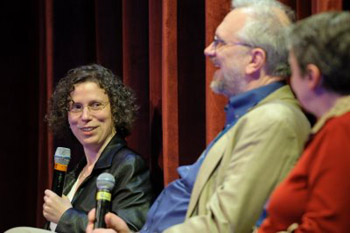 [3]animated shorts before progressing to Sita, her first feature. Her father taught at the University of Illinois. Her mother was an administrator there. Both have supported her in the making and distribution of Sita, and both were present throughout the festival.
[3]animated shorts before progressing to Sita, her first feature. Her father taught at the University of Illinois. Her mother was an administrator there. Both have supported her in the making and distribution of Sita, and both were present throughout the festival.
Here’s a transcript of our conversation (that’s Nina at the far left, Richard, and me). Applause, laughter, and a fast-talking film director at times defeated my efforts to catch every word of my recording, so some details have been lost.
KT: I know you want to talk about how you’ve been getting the film out to the public, but I’d like to start off by talking about the film itself, which is fascinating. I think we can start with the computer animation. A lot of people think that you were pushing a lot of buttons and somehow the computer was generating the images. But obviously you were generating them yourself by painting and collage and so forth. Could you just start with the process of what you did before you put this material into the computer and then what you did afterwards?
NP: Well, there are a whole bunch of different styles and techniques used in the film. The style of the musical numbers, actually I drew that in Flash using a lot of really simple tools, so the perfect circles have a smoothness that you don’t get by hand. By the way, I want to mention that what you saw was not 35mm. You saw HD-cam, and there are actually 35mm prints of this, and seeing it here was very strange. It was unusually solid, rock solid, a little bit troublingly solid, although that is the ideal that film technology has been striving for. But 35mm prints have all these scratches and splices, and grain and a kind of warmth that moves around, which is almost like a kind of very desirable filter that really warms up the film. So watching it in 35mm is different. I was noticing how computery it looked on the HD projection at this particular size, because I was looking for imperfections that simply weren’t there.
But anyway, yeah, I did some paintings on parchment paper. To me, some things were simple, because I only had me working on the animation, and I used as many computer shortcuts as I possibly could. Most of the technique was what’s called “cut-outs,” so I made pieces of things, moved them around, and the computer does what’s called “tweening.” [i.e., in-betweening, filling in the frames between key points] There’s a little bit of full animation in there. It would take a long time to say everything that I did.
KT: Yeah, but every bit of that visual material was something that you put into the computer in some fashion, so that-
NP: The computer didn’t draw it, that’s for sure. I drew it, whether I started with paper or drawing on a little [digital] graphics tablet or eventually I got what’s called a Cintiq [5], which is a monitor you can draw on. You can draw straight into a program through the monitor, and so what’s on the monitor-it tricks you into thinking you’re actually drawing on the screen, but it went through both my hand and the computer.
KT: Is this the kind of thing you teach? Do your students learn how to do this kind of animation?
NP: No. I’d love to teach this. A lot of the students are just not [inaudible]. So right now I’m teaching visual storytelling, which is a much more basic class, and I taught something called “classic film and video” for a while at Parsons [School of Design]. I actually really like to teach artists. I’m teaching people who already know what they want to say and already have a voice and just need a little bit of technical-it’s slightly faster if they ask me rather than reading a manual. I learned by reading manuals.
RL: It struck me that you’re a woman artist making an animated feature, and actually one of the very first animated features, done ten years before Snow White and the Seven Dwarfs, was Lotte Reiniger’s The Adventures of Prince Ahmed, [6] which also deals with Eastern myths. You actually did a little bit of the cut-out animation there, too, with the shadow-puppets. That brings a nice circularity-
NP: Well, hopefully this isn’t the last one!
KT: Was that the silent film that you referred to in your film?
NP: I still haven’t seen that film. First of all, everything has influenced me, because everything influences everything else. Culture [inaudible] language, so there’s a language of cell phones, a language of animation that comes from every piece of animation that’s been shared ever. So even if I haven’t been directly influenced by something, I haven’t seen the actual film, I will have been indirectly influenced by it simply keeping my eyes open.
RL: All the Annette Hanshaw songs are accompanied with the Flash animation, but it looked like there was a couple of different styles of Indian art represented there, from different periods. Tell us a little bit about what the choice was.
NP: The Ramayana is thousands of years old, and it also covers an enormous chunk of geography. It’s very popular not just in India but also in Cambodia, Thailand, Polynesia, Indonesia, this huge swath of South and Southeast Asia-parts of China. So there’s just this enormous range of art styles that have come up around it, and the styles I used in the film were influenced by just a tiny, tiny sample of that. Obviously shadow puppets. The designs were derived from puppets from Indonesia, Korea, Thailand, Malaysia, and also India. There’s a whole slew of paintings. There’s lots of Ramayana paintings that were actually commissioned by Muslim [inaudible] who had money. There were collages of these traditional arts. Everything went into the hopper, all going into my head Everything goes in there, grinds up, and comes out.
KT: Traditionally in animation the entire soundtrack is done first, which is not the way it’s done in regular live-action filmmaking, but of course it’s virtually impossible to synchronize cartoons if you have someone doing the voices after the animation is done. So could you tell us a little about the soundtrack and how much of it you had ready by the time you started the visuals?
NP: Well, I should say, the whole production, it’s not like I had everything ready when I started the visuals. The way you’re supposed to make a film, first you’re supposed to write a treatment, and then you’re supposed to write a script, and then you’re supposed to, if it’s animation, have everything designed and do breakdowns and storyboards and this and that, and then at the very end you animate it.
I didn’t have to do that, because it was just me working and it was with a computer. So I came up with things as I was going along. The whole structure of the story was there, because the Ramayana is this very well-established story that’s been told billions of times. I knew that story. I also had the songs, so the first thing that I synchronized and edited was the songs. As I was working on those, I was figuring out how the rest of the film was going to come together. The [inaudible] part of the film was the three narrators, who were just friends of mine who I convinced to go into a recording studio, and I asked some questions about the Ramayana. They were all very busy and went, “Oh, I should have read more before.” The conversation that they had was actually quite typical, because I had so many conversations with so many Indians, who-it was just uncanny, they really captured the twenty-first century zeitgeist of Ramayana, I guess.
RL: That intermission was a bit daring.
NP: I should mention that the 35mm print, depending on where you see it, it has surround sound and the HD only has stereo. If you see it on 35mm, depending on what speaker you’re near, you’ll hear different complete conversations coming out of each. Some of those conversations are extremely funny. I recommend the left rear speaker. There will be Will Franken, who’s a distribution executive, talking about unsellable the film is. And there are people on the front right speaking Hindi. I think they’re saying, “I thought this was a children’s film.”
So, yes, intermission. Old American musicals had intermissions. I was watching some of them while I was working on the film, and sure enough, two-thirds of the way through, intermission comes up. Bollywood films still have intermissions-a three- or four-hour-long Bollywood film has a little gap. So it was a tribute to both old American musical films and all Bollywood films. When I showed the film in Livingston, New Jersey to an audience of primarily Indian-Americans, during intermission they just left for 15 minutes. And they missed my favorite part of the film, which is the part that comes a minute after the intermission.
Nina’s favorite part, shortly after the intermission
KT: I can second that statement about the 35mm, because I was lucky enough to see this film three weeks ago in 35mm at the Wisconsin Film Festival, and it’s a different experience. I’ve enjoyed both of them, but I think there are definite advantages to 35.
It’s actually much easier for most people to see this film on a computer screen or television, because you chose a very unusual way to disseminate the film to the public. Can you talk a little about that?
NP: Why, yes, I can! You can see this film for free online if you go to sitasingstheblues.com [9] and follow a variety of links and get the film. You can get everything from a streaming version from New York Public Television to a 200 gigabyte file from which you can make your own 35mm print if you have $30,000 to download it. Briefly, every file I have for the film is either online now or it’s going to go online. It’s a completely decentralized distribution model. People have compared it to Radiohead’s [inaudible] English model [for their “In Rainbows” album, 2007], but that’s different, because that relied on a single, central location where you got the audio, and it was tracked. It was simply what you decided to pay.
Mine is totally decentralized. I shouldn’t even call it “mine” anymore. It’s yours. This film belongs to you and everybody else in the world. The audience, you and the rest of the world is actually the distributor of the film. So I’m not maintaining a server or host or anything like that. Everyone else is. We put it on archive.org, a fabulous website, and encourage people to BitTorrent it and share it. That’s what’s happening, and we hope people do it more. There’s also broadcast versions, which you can download. If anyone here is from a television station, you can broadcast this for free.
Which begs the question, why is Nina Paley giving her work away for free? Doesn’t she want to get money? The answer is yes, I want to get money, and I believe that I will get money. I think I am getting money from this, because the more people share the film, the more valuable the film becomes. I have told people after screenings that they can get the film for free online, but I have some DVDs which I sell for twenty bucks, and here for twenty-five bucks-the Virginia is still remodeling, so this is for the Virginia.
I should also mention regarding DVDs that we, my mom-Oh, I should mention my mom! Sorry, I[inaudible] my parents, of course, who gave me the gift of life and all that, but my mom, who gave Sita Sings the Blues the gift of being its festival-relations manager, which is a huge, huge job. For those who don’t know, my mom was the main administrator of the math department of the University of Illinois and is a spreadsheet master and business-communications master and stuff like that and has been just essential to the film having such a successful festival life. So, thank you, mom! [Applause]
Anyway, I have made thousands of festival screeners so that festivals will have something to preview, and we’re down to the last 35, or at least we were this morning, and we handed them to the people in the Virginia, and that’s it for DVDs until a few weeks from now I’ll have the new purchasable DVD edition available.
RL: Will there be special features?
NP: Because the film is free, people can subtitle it freely, and the new one will have some subtitles. There’s gonna be more subtitles online. It’s been translated into French and Hebrew and Spanish and Italian and pirate. [applause and laugher covers a stretch of speech] The thing is, the film is now half-way. It will just continue growing, so whatever the DVD is, it’s just snatched off the stuff we have as of this week. So it’ll be the film, it’ll be a bonus feature called Fetch, a film I made, it’ll be some subtitles, I think there’ll be a couple different audio options.
It’ll be a very nice package, because basically what I’m selling is packaging for the film. If you have a computer, you’ve got your own packaging. You just download it. But many people just the same want an actual printed package. There’ll be two editions. There’s the artist’s edition, a limited edition of 4,999 DVDs, because for every five thousand DVDs I sell, I have to pay the licensers more money. You may think that’s too bad, and it’s OK if the other DVD distributors pay the licensers more money, but I [inaudible] paid $5,000 in order to decriminalize the film, so that I wouldn’t go to jail.
Jean Paley from the audience: Fifty thousand!
NP: Fifty thousand, yeah. Fifty thousand dollars is enough.
KT: Which is for the song rights.
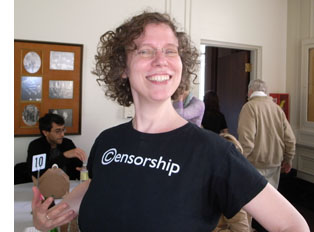 [10]NP: Yes. Those old songs. I cannot thank Roger enough for writing about this film. Also, after he wrote about it on his blog, my colleague, a professor of copyright law here, said, “Does he know about the copyright issue of the songs?” The film uses old songs that were written and performed in the late 1920s. Had they been from 1923, they would be in public domain now. When they were written, they were supposed to be in public domain in the 1980s, but there have been these continuous, retroactive copyright extensions, so they may never enter the public domain.
[10]NP: Yes. Those old songs. I cannot thank Roger enough for writing about this film. Also, after he wrote about it on his blog, my colleague, a professor of copyright law here, said, “Does he know about the copyright issue of the songs?” The film uses old songs that were written and performed in the late 1920s. Had they been from 1923, they would be in public domain now. When they were written, they were supposed to be in public domain in the 1980s, but there have been these continuous, retroactive copyright extensions, so they may never enter the public domain.
We were so relieved that Roger agreed that what copyright law has become is really not serving culture or people. These copyright extensions have really gotten way out of control. [applause] They [inaudible] me so much that I actually question copyright fundamentally, but even those who don’t agree, I think, that retroactively assigning copyrights is not actually acting as an incentive for dead artists to create more art.
Whereas these songs. It’s a scandal, these beautiful songs! Many people have never heard of them until seeing my film. That’s just a crime. She was a huge seller in the twenties. Huge! Why is it that we can’t hear her music? It’s because all the rights are controlled by corporations, and anybody who dares to share Annette Hanshaw’s music is risking a lawsuit or jail. As I did. As I decided I was willing to do. I didn’t realize I was doing civil disobedience at the time. I didn’t realize how severe the possible punishments were for doing this kind of thing, but even had I know I would have done it anyway. I have no regrets. Now, I’m turning into a full-time free-culture activist. [applause]
Some of you may know my dad is a retired math professor here. But I grew up in this science and engineering culture. In all these books about copyright, people always talk about scientists and how scientists share information. How it’s really important, this really strong ethic of sharing information. Scientists seek to discover some really great information to share it with the community, and that actually benefits the contributing scientist.
As an artist, it’s actually exactly the same. My status vastly increases as I share this film. But I think it’s quite possible that the way I was growing up here formed me that way, to see it this way. A lot of artists don’t see it this way. People see it as property. I just wanted to share what I’ve been thinking about a lot. [applause]
RL: Has your film prompted an Annette Hanshaw revival?
NP: Not an official one. I should mention that the only reason that these songs exist in a form in which we can hear them at all is because of the efforts of underground record collectors, because the corporations that have the official rights to control this music hadn’t done it. They actually scrapped the masters. There’s no surviving masters of Annette Hanshaw’s recordings, because they were so very valuable that in the forties they were sent for scrap metal. And yet somehow it would be theft if somebody in America released her recordings today.
But yeah, there’s this wonderful network of record collectors who just preserved her stuff on lacquer, and that’s how I originally heard her songs. I was staying in the home of a record collector, and he actually had Annette Hanshaw on 78s. And this is the tip of the iceberg. There’s so much amazing culture that we’ve forgotten all about and can’t get at. There’s this wealth of films that’s just sitting there, that nobody can restore, because if you restore a film you don’t have the rights to, you can get sued for showing it! And it’s very expensive to restore films, so the result is, nobody wants to touch it. Everyone is scared, and our cinematic history is disintegrating. It doesn’t last. Records actually last longer than film.
KT: We should point out that you have a very informative website, ninapaley.com.
NP: Yeah, it’s now blog.ninapaley.com [11], and there’s also sitasingstheblues.com [9], and I’m also artist-in-residence at QuestionCopyright.org [12].
KT: Most of the ways to get the film out to people that you’ve talked about would be DVDs or downloaded copies, but your film is still being shown in a lot of festivals, well into the future.
NP: Yeah, festivals and also cinemas. Hurray for independent cinemas! I support them, and they support me. [applause] There’s some great cinemas programming it. It’s going to be in Chicago at the Gene Siskel Film Center, very soon. And it’s going to be in Vancouver. It’s going to be in some other cities. And there’s no real time limit. There’s no advertising for this film, no paid advertising. The audience is also the public-relations department, so it’s gone completely by word of mouth, word of web, word of blog. There’s absolutely no end time. It can be screened anytime. There are some prints circulating right now, and hopefully any cinema that has a little off time and wants to give it a shot, can program it.
KT: Your mother was telling me that the film will be probably in two hundred festivals.
NP: Not two hundred. I think it’s been in a hundred.
KT: Well, there’s a long list on your website that goes into 2010, I think, so [to audience] you want to tell your friends who live in those various cities, see it on the big screen!
[Note: the list of screenings and festivals [13] on the film’s website numbered exactly 200 as of May 4.]
NP: When I decided to give it away free online, what finally made me realize this was viable was when I realized that this didn’t mean it wouldn’t be seen on the big screen, that the internet is not a replacement for a theater. It’s a complement. Many people will see it online and go, “Wow, I wish I could see this on the big screen!” And so they can, and some people like to see it more than once. Another thing is, you see it online, and that increases the demand for the DVDs. So it’s the opposite of what the record and movie industries say. Actually, the more shared something is, the more demand there is for it. [applause]
RL: Are you doing this for your short films, too?
NP: I would like it for the short films. It’s simply a matter of time. I want to do it with my comic strips. I’m still seeking a volunteer, although someone contacted me from the U[niversity] of I[llinois], I think from the library, whom I need to call. Maybe everything will be scanned and uploaded right here from Urbana, which would be awesome. But yeah, I want to go back. Just as Congress is retroactively extending copyrights, I’m retroactively de-copyrighting all of my stuff and sharing it, because that will make it more valuable. Imagine some original comic strip that everybody knows. That’s much more valuable to people than a comic strip that no one’s ever seen. Andy Warhol, for example. Some Warhol print just fetched some huge price at auction. There was a photo of it up in the newspaper. We all know what Andy Warhol’s prints look like, even though most of us have never seen them in the flesh. We all know that they’re worth a lot, ‘cause they’re famous. They’re famous because people reproduce images of them.
[People do indeed. Here’s another of Nina’s:]
